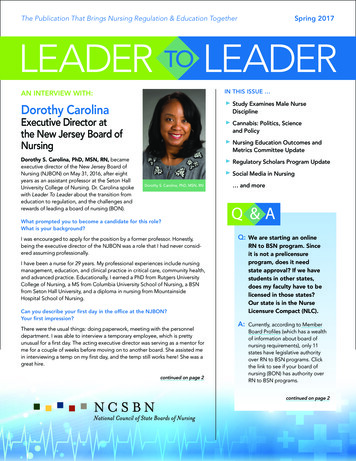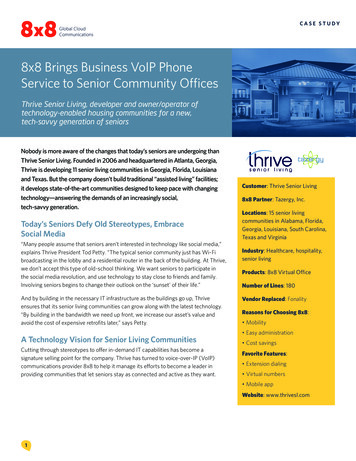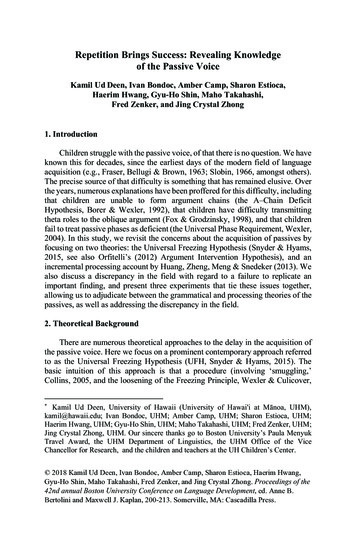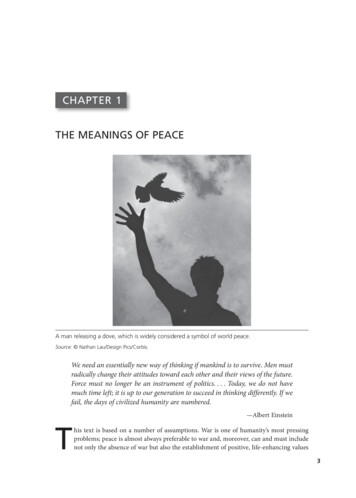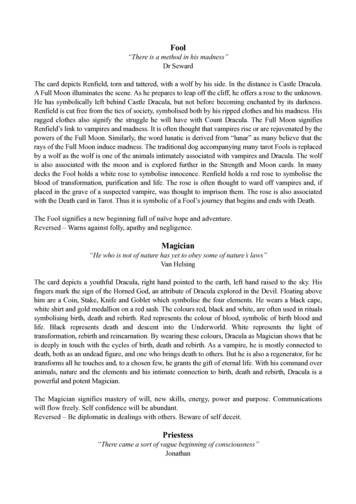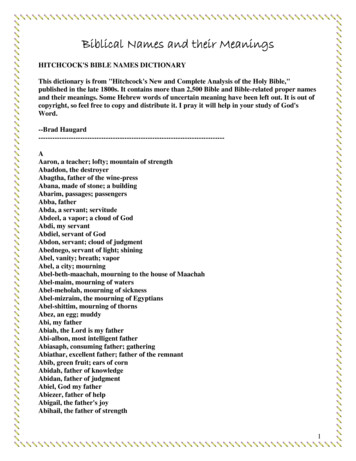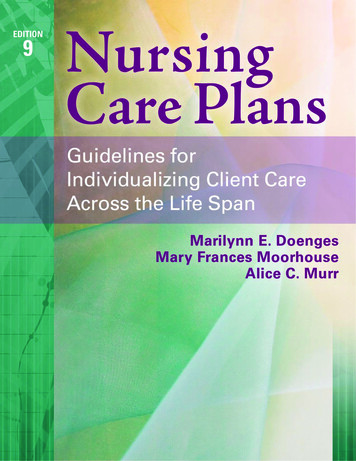
Transcription
3041 FM i-xxxii 29/01/14 9:16 AM Page iThe very best patient care begins with the very bestcare planning resources now and throughout your career!Doenges, Moorhouse & MurrNurse’s Pocket GuideDiagnoses, Prioritized Interventionsand RationalesThe perfect portable guide for practitioners and nursing studentson the go! Here’s everything you need to select the appropriatediagnoses for your patients and develop safe and effective care plans.Doenges & MoorhouseAPPLICATION OF NURSING PROCESSAND NURSING DIAGNOSISAn Interactive Text for Diagnostic ReasoningMaster the nursing process with this step-by-step approach to thewhys and hows, while you develop the diagnostic reasoning andproblem-solving skills you need to ‘think like a nurse.’Doenges, Moorhouse & MurrNursing Diagnosis ManualPlanning, Individualizing, andDocumenting Client CareRely on this complete reference to identify interventionscommonly associated with specific nursing diagnoses acrossthe lifespan, and to help plan, individualize, and documentcare for more than 800 diseases and disorders.Order your copies today!www.FADavis.comTaber’s 22 brings meanings to life!Taber’s 22Edited by Donald Venes, MSJ, MDMeet the needs of diverse learning stylesand today’s time-pressed students withFREE mobile and web access, flash-cardapp, audio pronunciations, interactivelearning activities, and more!WEB. MOBILE. PRINT.The choice is yours.www.Tabers.com
3041 FM i-xxxii 29/01/14 9:16 AM Page iiDon’t miss thenursing diagnosis andcare planning resourcesonline atA wealth of online tools help you learn to plan andimplement safe, individualized care.Visit DavisPlus.fadavis.com today!§§ Concept Care Map Generator§§ Care Plan Case Studies§§ Learning Activities§§ Gordon’s Functional Health Case Studies§§ Interactive Assessment Tool§§ Online Disorder Lookup§§ Care Plan Template§§ Nursing Diagnoses Arranged by Maslow Hierarchywww.FADavis.com
3041 FM i-xxxii 29/01/14 9:16 AM Page iiiINDEX OF DISEASES/DISORDERSThis is 1 of 2 indexes in the book. It should be compiled by the indexer and only needs to contain the disorder/disease and the page numberin which the care plan for that disorder/disease begins.Acid-base imbalancesrespiratory, 179metabolic, 450Acquired immunodeficiency syndrome (AIDS),689Acute coronary syndrome (ACS), 58Acute kidney injury (acute renal failure), 505Adult leukemias, 484Alcohol: acute withdrawal, 800Alzheimer’s disease, 743Amputation, 616Anemia–iron deficiency, anemia of chronicdisease, pernicious, aplastic, hemolytic, 459Angina: chronic/stable, 67Anorexia nervosa, 340Aplastic anemia, 459Appendectomy, 315Asthma, 118Bariatric surgery, 367Benign prostatic hyperplasia, 559Brain infections: meningitis and encephalitis,229Bulimia nervosa, 340Burns: thermal, chemical, and electrical—acuteand convalescent phases, 638Cancer, 827Cardiac dysrhythmias, 87Cardiac surgery: postoperative care, 98Cardiomyoplasty, 98Cerebrovascular accident/stroke, 214Chemical burns, 638Cholecystectomy, 335Cholecystitis with cholelithiasis, 329Cholelithiasis, 329Chronic obstructive pulmonary disease (COPD)and asthma, 118Cirrhosis of the liver, 412Colostomy, 304Coronary artery bypass graft, 98Craniocerebral trauma–acute rehabilitativephase, 197Crohn’s disease, 291Dementia (Alzheimer’s type or vascular), 743Diabetes mellitus/diabetic ketoacidosis, 377Diabetic ketoacidosis, 377Disaster considerations, 858Disc surgery, 237Dysrthymias, 87Eating disorders: anorexia nervosa/bulimianervosa, 340Eating disorders: obesity, 358Electrical burns, 638Encephalitis, 229End-of-life care/hospice, 848End stage renal disease, 517Enteral feeding, 437Esophageal bleeding, 281Extended care, 781Fecal diversions: postoperative care of ileostomyand colostomy, 304Fluid and electrolyte imbalances, 886Fractures, 601Gastrectomy/gastroplasty, DavisPlusGastric bypass, 367Gastric partitioning, 367Glaucoma, DavisPlusGraves’ disease, 391Heart failure: chronic, 43Hemodialysis, 544Hemolytic anemia, 459Hemothorax, 150Hepatitis, 400Herniated nucleus pulposus, DavisPlusHIV-positive client, 677Hospice, 848Hypercalcemia (calcium excess), 909Hyperkalemia (potassium excess), 903Hypermagnesemia (magnesium excess), 915Hypernatremia (sodium excess), 897Hypertension: severe, 33Hyperthyroidism (Graves’ disease,thyrotoxicosis), 391Hypervolemia (extracellular fluid volumeexcess), 886Hypocalcemia (calcium deficit), 906Hypokalemia (potassium deficit), 900Hypomagnesemia (magnesium deficit), 912Hyponatremia (sodium deficit), 893Hypovolemia (extracellular fluid volumedeficit), 890Hysterectomy, 581Ileostomy, 304Inflammatory bowel disease: ulcerative colitis,Crohn’s disease, 291Iron deficiency anemia, 459Laminectomy, 237Laryngectomy, DavisPlusLewy body disease, 743Leukemias, 484Lung cancer: postoperative care, 141Lymphomas, 494Mastectomy, 589Meningitis, 229Metabolic acid-base imbalances, 450Metabolic acidosis—primary base bicarbonatedeficiency, 450Metabolic alkalosis—primary base bicarbonateexcess, 455Minimally invasive direct coronary arterybypass, 98Multiple sclerosis, 266Myocardial infarction, 75Obesity, 358Obesity: bariatric surgery, 367Pancreatitis, 426Parenteral feeding, 437Pediatric considerations, 872Peritoneal dialysis, 539Peritonitis, 320Pernicious anemia, 459Pneumonia, 129Pneumothorax, 150Primary base bicarbonate deficiency, 450Primary base bicarbonate excess, 455Primary carbonic acid deficit, 184Primary carbonic acid excess, 179Prostatectomy, 566Psychosocial aspects of care, 729Pulmonary emboli considerations, 109Pulmonary tuberculosis (TB), 170Radical neck surgery, DavisPlusRenal calculi, 573Renal dialysis—general considerations, 529Renal failure: acute, 505Renal failure: chronic, 517Respiratory acid-base imbalances, 179Respiratory acidosis (primary carbonic acidexcess), 179Respiratory alkalosis (primary carbonic aciddeficit), 184Rheumatoid arthritis (RA), 709Ruptured invertebral disc, DavisPlusSeizure disorders, 188Sepsis/septicemia, 665Sickle cell crisis, 469Spinal cord injury (acute rehabilitative phase),248Stroke, 214Substance use disorders (SUDs), 815Surgical intervention, 762Thermal burns, 638Thrombophlebitis: venous thromboembolism, 109Thyroidectomy, DavisPlusThyrotoxicosis, 391Total joint replacement, 625Total nutritional support: parenteral/enteralfeeding, 437Transplantation considerations—postoperativeand lifelong, 719Tuberculosis (TB), pulmonary, 170Ulcerative colitis, 291Upper gastrointestinal/esophageal bleeding, 281Urinary diversions/urostomy (postoperativecare), 548Urolithiasis (renal calculi), 573Urostomy, 548Valve replacement, 98Vascular dementia, 743Ventilatory assistance (mechanical), 157Wound care: complicated or chronic, 657Herdman, T.H. (Ed.). Nursing Diagnoses—Definitions and Classification 2012–2014. Copyright 2012, 1994–2012 NANDA International.Used by arrangement with John Wiley & Sons Limited. In order to make safe and effective judgments using NANDA-I nursing diagnosesit is essential that nurses refer to the definitions and defining characteristics of the diagnoses listed in this work.
3041 FM i-xxxii 29/01/14 9:16 AM Page ivKEY TO ESSENTIAL TERMINOLOGYClient Assessment DatabaseProvides an overview of the more commonly occurring etiology and coexisting factors associated with a specific medical and/or surgical diagnosis or health condition as well as the signs and symptoms and corresponding diagnostic findings.Nursing PrioritiesEstablishes a general ranking of needs and concerns on which the Nursing Diagnoses are ordered in constructing the plan of care. Thisranking would be altered according to the individual client situation.Discharge GoalsIdentifies generalized statements that could be developed into short-term and intermediate goals to be achieved by the client before being“discharged” from nursing care. They may also provide guidance for creating long-term goals for the client to work on after discharge.Nursing DiagnosisThe general need or problem (diagnosis) is stated without the distinct cause and signs and symptoms, which would be added to create aclient diagnostic statement when specific client information is available. For example, when a client displays increased tension, apprehension,quivering voice, and focus on self, the nursing diagnosis of Anxiety might be stated: severe Anxiety related to unconscious conflict, threatto self-concept as evidenced by statements of increased tension, apprehension; observations of quivering voice, focus on self.In addition, diagnoses identified within these guides for planning care as actual, risk, or health-promotion can be changed or deletedand new diagnoses added, depending entirely on the specific client situation or available information.May Be Related to/Possibly Evidenced byThese lists provide the usual or common reasons (etiology) why a particular need or problem may occur with probable signs and symptoms,which would be used to create the “related to” and “evidenced by” portions of the client diagnostic statement when the specific situation isknown.When a risk diagnosis has been identified, signs and symptoms have not yet developed and therefore are not included in the nursingdiagnosis statement. However, interventions are provided to prevent progression to an actual problem. Furthermore, health-promotion diagnoses (readiness for enhanced) do not contain related factors, but do have defining characteristics for the “evidenced by” segment of theclient diagnostic statement.Desired Outcomes/Evaluation Criteria—Client WillThese give direction to client care as they identify what the client or nurse hopes to achieve. They are stated in general terms to permit thepractitioner to modify or individualize them by adding time lines and specific client criteria so they become “measurable.” For example,“Client will appear relaxed and report anxiety is reduced to a manageable level within 24 hours.”Nursing Outcomes Classification (NOC) labels are also included. The outcome label is selected from a standardized nursing languageand serves as a general header for the outcome indicators that follow.Actions/InterventionsNursing Interventions Classification (NIC) labels are drawn from a third standardized nursing language and serve as a general header forthe nursing actions that follow.Nursing actions are divided into independent—those actions that the nurse performs autonomously—and collaborative—those actionsthat the nurse performs in conjunction with others, such as implementing physician orders. The interventions in this book are generallyranked from most to least common. When creating the individual plan of care, interventions would normally be ranked to reflect the client’sspecific needs and situation. In addition, the division of independent and collaborative is arbitrary and is actually dependent on the individualnurse’s capabilities, agency protocols, and professional standards.RationaleAlthough not commonly appearing in client plans of care, rationale has been included here to provide a pathophysiological basis to assistthe nurse in deciding about the relevance of a specific intervention for an individual client situation.Clinical PathwayThis abbreviated plan of care or care map is event- or task-oriented and provides outcome-based guidelines for goal achievement within adesignated length of stay. Several samples have been included to demonstrate alternative planning formats.
3041 FM i-xxxii 29/01/14 9:16 AM Page vNURSING DIAGNOSES ACCEPTED FORUSE AND RESEARCH FOR 2012–2014Activity Intolerance [specify level]Activity Intolerance, risk forActivity Planning, ineffectiveActivity Planning, risk for ineffectiveAdverse Reaction to Iodinated Contrast Media, risk forAirway Clearance, ineffectiveAllergy Response, risk forAnxiety [specify level]Aspiration, risk forAttachment, risk for impairedAutonomic DysreflexiaAutonomic Dysreflexia, risk forBehavior, disorganized infantBehavior, readiness for enhanced organized infantBehavior, risk for disorganized infantBleeding, risk forBlood Glucose Level, risk for unstableBody Image, disturbedBody Temperature, risk for imbalancedBreast Milk, insufficientBreastfeeding, ineffectiveBreastfeeding, interruptedBreastfeeding, readiness for enhancedBreathing Pattern, ineffectiveCardiac Output, decreasedCaregiver Role StrainCaregiver Role Strain, risk forChildbearing Process, ineffectiveChildbearing Process, readiness for enhancedChildbearing Process, risk for ineffectiveComfort, impairedComfort, readiness for enhancedCommunication, impaired verbalCommunication, readiness for enhancedConfusion, acuteConfusion, chronicConfusion, risk for acuteConstipationConstipation, perceivedConstipation, risk forContaminationContamination, risk forCoping, compromised familyCoping, defensiveCoping, disabled familyCoping, ineffectiveCoping, ineffective communityCoping, readiness for enhancedCoping, readiness for enhanced communityCoping, readiness for enhanced familyDeath AnxietyDecision-Making, readiness for enhancedDecisional ConflictDenial, ineffectiveDentition, impairedDevelopment, risk for delayedDiarrheaDignity, risk for compromised humanDisuse Syndrome, risk forDiversional Activity, deficientDry Eye, risk forElectrolyte Imbalance, risk forEnergy Field, disturbedEnvironmental Interpretation Syndrome, impairedFailure to Thrive, adultFalls, risk forFamily Processes, dysfunctionalFamily Processes, interruptedFamily Processes, readiness for enhancedFatigueFearFeeding Pattern, ineffective infantFluid Balance, readiness for enhanced[Fluid Volume, deficient hyper/hypotonic]Fluid Volume, deficient [isotonic]Fluid Volume, excessFluid Volume, risk for deficientFluid Volume, risk for imbalancedGas Exchange, impairedGastrointestinal Motility, dysfunctionalGastrointestinal Motility, risk for dysfunctionalGastrointestinal Perfusion, risk for ineffectiveGrievingGrieving, complicatedGrieving, risk for complicatedGrowth, risk for disproportionateGrowth and Development, delayedHealth, deficient communityHealth Behavior, risk-proneHealth Maintenance, ineffectiveHome Maintena
Communication, impaired verbal Communication, readiness for enhanced Confusion, acute Confusion, chronic Confusion, risk for acute Constipation Constipation, perceived Constipation, risk for Contamination Contamination, risk for Coping, compromised family Coping, defensive Coping, disabled family Coping, ineffective Coping, ineffective community

